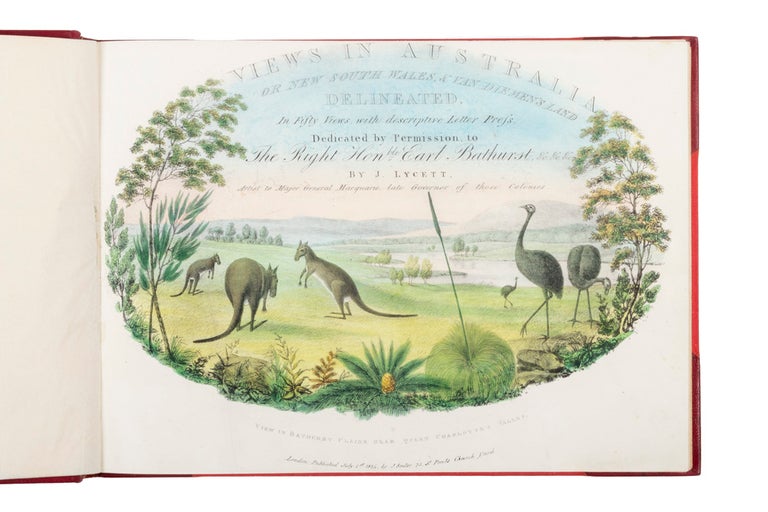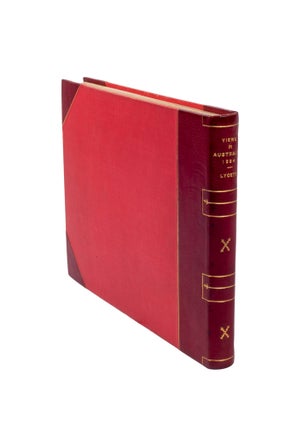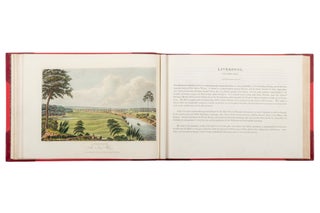Views in Australia, or New South Wales and Van Dieman's Land Delineated…
London: J. Souter, 1825.
Oblong folio, pictorial lithographed title and 48 coloured aquatint views and one lithographed illustration after drawings by Joseph Lycett, with descriptive text, two folding maps; half red calf, marbled end papers and all edges gilt.
A pivotal work in Australian landscape art: "postcards from another planet"
A specially desirable copy of the great Australian colourplate book, the most important collection of antipodean landscapes and a landmark in the development of Australian illustrated books.
A specially desirable copy of the great Australian colourplate book, the most important collection of antipodean landscapes and a landmark in the development of Australian illustrated books.
Image one, "North View of Sydney, New South Wales" is found here in two states; the usual aquatint illustration and the very rare lithographed version. Lycett, a competent lithographer produced only two Australian images in lithography; one of Sydney and one of Hobart. It was originally planned that all the illustrations in "Views..." would be hand coloured lithographs, but as the prints when taken from the stone soon lost definition the publishers turned to aquatints, "in order that the accurate and highly finished drawings by Mr. Lycett might be presented 'with that full and complete effect of light and shade allowed by engraving'.
Lycett's charming, highly-coloured views are justly famous for providing such a remarkable visual record of Australia in the early colonial period. Lycett's work not only offers an historical snapshot of New South Wales and Tasmania in the early decades of settlement, but from the point of view of colonial architecture it provides a significant record of some of the colony's most important houses and country seats, and an invaluable contextual record of many lesser-known buildings and indeed building types.
Lycett had arrived in New South Wales as a convict in 1814. Trained as a portrait and miniature painter in Staffordshire, his services as a professional artist were much in demand and he was soon working for the publisher Absalom West. He was appointed artist to Major-General Macquarie, the governor of New South Wales. Impressed with Lycett's talents, Macquarie sent three of his drawings to Earl Bathurst, Secretary of the Colonies (the dedicatee of the Views) who, it is supposed in payment, granted a pardon to the artist.
Little is known of Lycett after the publication of the Views, which - with Wallis' Historical Account - marks the end of an era in the publication of Australian illustrated books. Governor Macquarie's departure and the deaths of both Lewin and Lycett meant that the illustrated books to follow would be on a rather less ambitious scale. 'As far as we know Lycett produced no more work after the completion of his Views in 1825. In the Advertisement to the complete work, issued with the first part in July 1824, Lycett announced that… he intended to publish 'in the same size and manner, the Natural History of Australia'. It is not known what became of this project. In 1825 Lycett was in his early fifties and still, no doubt, the incurable alcoholic Commissioner Bigge reported him to be a few years before; it is probable that he did not live long enough to complete the project… The death, or at any rate, the silence of Lycett after 1825 marked the end of an era in Australian plate books. The lavish productions of Wallis and Lycett celebrated the expansiveness and the buoyancy of the Macquarie age. With Macquarie gone, Lewin dead and Lycett departed, artistic life in the colony was less robust in the 1820s. Australian plate books were still being published, but they were in most cases more humble productions than those of the preceding decade' (Australian Rare Books).
Lycett's work (his 'enticing book') was memorably celebrated by the late Edmund Capon in the ABC documentary "Art of Australia", commenting that 'when these pictures were first seen in Britain, it was something of a revelation, a little bit like receiving postcards from another planet'.
Provenance: F.G. Coles (mid-century Australian collector, with bookplate).
Wantrup, 218b.
Condition Report: A very fine copy
Price (AUD): $65,000.00
US$41,658.34 Other currencies







